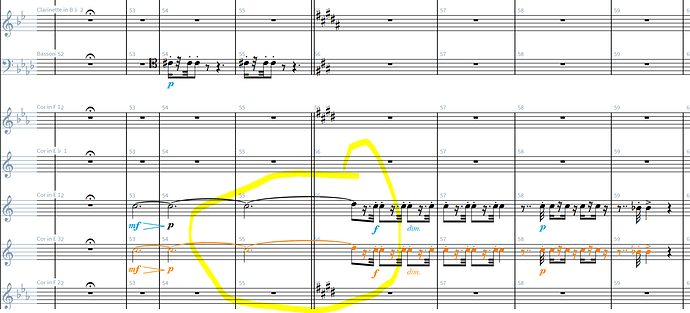Hello,
I’m really new to Dorico. Normally I use Sibelius for professional engraving, but some features of Dorico sound that great that I’m trying to create a first large opera project with Dorico.
I have two problems regarding transposing instruments:
No. 1: Is it possible to change the way how the transpositions are named in the instrument names. I have a french piece, so I need french instrument names. This is easy to change so far, but how can I change for example Horn 1 in F to Cor 1 en fa?
Changing “Horn” to “Cor” was no problem, but I didn’t found any function to change the naming of the transposition.
No. 2: I don’t know what is happening there, mabe it is a bug, but I have a Horn in E without accidentals. At one point the general key is changing from Db major to E major. The Horn is holding a C, with the changing of the general key it is changing to d. Please see attached a screenshot.
Maybe someone can help here?
Best wishes from Germany!
Paul
Short answer:
This looks like bug but there is a workround: untie the C and D, at which point the D will turn into a D double flat.
Replace the D with a C in a different voice, select the two C’s and tie them together. You need different voices to stop Dorico respelling the second note back to a D double flat.
Long answer:
There is something weird going on here (and apparently involving a one or maybe two bugs), probably because of the extreme transposition situation of using a Horn in E with a key signature of four flats.
I tried reproducing the basics of this, and if I switch to a concert pitch score the written C in the horn part becomes F flat, not the E you might have expected. A concert pitch E natural becomes a written B sharp.
The written C is tied to a written D double flat which seems to have lost its accidentals. You can prove that by turning the accidental on explicitly in Engrave mode, or by deleting the tie.
If you change to the instrument to “Horn in E with key signature”, the transposing key signature corresponding to 4 flats is 4 sharps, not the 8 flats you would get by following the basic “rules” for transposing instruments.
Maybe the notation would have been more logical with a “Horn in F flat (no key signature)” but you can’t create one of those in Dorico.
Somebody from the Dorico team will have to explain how much of all that is by design and how much is a bug! I can’t think of any other transposing instruments in E to compare this with (but valveless horns in E were definitely real instruments, going back at least as far as Haydn).
A possible rationalization (but not a good reason) for what happened: because the transposed key has to be 4 sharps not 8 flats, Dorico converts your “Horn in E” internally into a Horn in F flat" to do the transpositions, and then reverts to “Horn in E” at your key signature change. But the tied note ended up as “half one thing and half another”.
Wow, thank you very much. It worked. We will also do a alternative version of the horn parts in which it is only one horn in F, so it will become much more easier to read and to play the part…
Now it’s only the problem with the instrument names. Can you or anyone help with this, too?
Thanks again!
Paul, in the Edit Names dialog, set transposition to never show, and add it manually as desired.
Regarding the original transposition problem reported here, just to say that we’ve not forgotten about it and we will look into it in due course.
